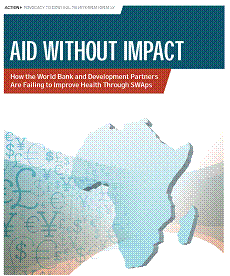The World Bank’s “horizontal” approach to health falls horizontal?
The history of foreign aid for global health has seen a cycling back and forth between two alternative approaches. The “vertical” approach focuses on fighting one disease at a time, and in Africa has been very effective in targeting smallpox, Guinea worm, measles, and river blindness, to name a few examples. After large initial successes though, diminishing returns to vertical programs set in. The “horizontal” approach instead invests sector-wide to make health systems work to administer prevention and treatment for all diseases. (For more on the history and pros and cons of these approaches, see Can the West Save Africa, pp 57-60). Since the late 1990s, the Bank and other donors have shifted resources to back the idea that “it’s the health system, stupid.” (According to the Institute for Health Metrics and Evaluation, health sector support shot up from $2 million in 1998 to $937 million in 2007, and surpassed specific funding for TB and malaria for the first time in 2006.)
Strangely enough, whether this resource shift has actually improved health has never really been tested.
 A new report funded by the Bill and Melinda Gates Foundation found that sector-wide approaches (aka SWAps—the development industry never misses the chance to make a silly acronym) “are not yet being implemented in a way that has led to improvements in health outcomes in effective, efficient, measurable, or sustainable ways.” In other words… SWAps don’t work.
A new report funded by the Bill and Melinda Gates Foundation found that sector-wide approaches (aka SWAps—the development industry never misses the chance to make a silly acronym) “are not yet being implemented in a way that has led to improvements in health outcomes in effective, efficient, measurable, or sustainable ways.” In other words… SWAps don’t work.
Written by Richard Skolnik, Paul Jensen and Robert Johnson of ACTION (Advocacy to Control TB Internationally), the report looks especially at whether the Bank’s sector-wide programs are associated with success in TB detection and treatment, and concludes with a number of alarming or surprising findings. (We don’t know if the authors have a predisposition towards the vertical approach given their affiliation with advocacy on one disease, but they do seem to ask the right questions.)
First, the authors find little evidence of the impact of SWAps on health outcomes, and what little there is, is mixed at best. The World Bank’s own evaluation picks up on a “general lack of attention to results,” “insufficient attention to ensuring that SWAps are technically sound,” “a general failure to monitor country expenditures,” and “very weak monitoring and evaluation of the health programs that SWAps are supporting.” In the history of SWAps, there has been only one rigorous, independent evaluation, in Tanzania.
Second, only three of the 15 Bank SWAp projects in sub-Saharan Africa from 2001-2008 even included indicators for detection of TB cases and successful treatment of TB. And in only one country (Tanzania), a SWAp “might” be linked to an actual health outcome: higher rates of TB treatment success.
Third, the aid workers and health experts interviewed for the evaluation said that SWAps focus on the process of coordinating aid delivery, which has become an end in itself, obscuring the need to actually increase successful treatment and decrease deaths. NONE of them questioned the need to work through SWAps BUT they almost all agreed there is “little evidence” that SWAps are associated with improved health outcomes.
This suggests to us that it's not only about correctly choosing the right mix of horizontal and vertical but whether ANY approach will work unless it has feedback and accountability. Is this why SWAps were a good idea in theory but a disaster in practice?
What to do? The authors have some suggestions, which are a little hard to believe aren’t already being done as a matter of course: Create incentives to focus on results not the process, drastically increase transparency of project information and evaluation, and do independent program evaluation.
Come to think of it, the donors’ behavior reminds us of Aid Watch’s analogy from Monday. Here, the Bank sends truckloads of money down the same SWAps road, ignoring increasingly obvious and urgent signs that the Bank should change course. But still it hurtles along, unfazed by even its own evaluators shouting from the side of the road that what it’s doing isn’t working.
 From Aid to Equality
From Aid to Equality
